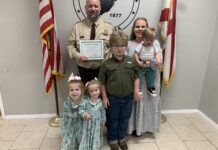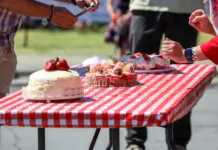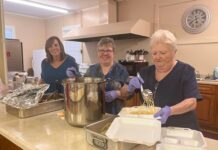I’ve been constantly reminded of my grandparents’ house this morning. First, I got up way before daylight, about 4:15 a.m., which they always did, else they’d never have enough hours in the day to work in the fields and all the other things it took to feed 11 children. By the time the sun came up they’d done what we would consider a half-day’s work. My granddaddy probably thought of sunrise as we think of midday.
It might have been the cold that brought them and their house so vividly to mind, because on winter mornings like this, it was frigid in those bedrooms! We’d been tucked in the night before under as many as 14 quilts, but that mattress was still awfully cold until your body heat caused it to warm enough for you to drift off to sleep in a little nest that you’d wallowed out for your body, knees tucked up as far as they’d go into the fetal position, and only your nose sticking out from under the little tent you’d made with the quilt to cover your head as best you could. You drifted off to sleep with the beep from the electric fence box playing its little annoying lullaby.
They lived on a paved road. Many people didn’t at that time in the late 1950s. From way down toward Russellville you could hear the 18-wheelers coming full throttle. The whine peaked right about the place even with the house, and then you heard them gear down for the sharp curve just past my grandparents’ place. The house, which I’m almost sure was formerly a dog-trot style house, was by necessity large, holding 13 people when all of the kids were still at home, and it was impossible to heat back then, with no such thing as central units or inferred heaters. They heated only the two front rooms, the kitchen by stove, and the living room, or front room, was kept warm by a huge old coal heater, kept stoked and filled by whichever boy had the misfortune to be the first to have to visit the outhouse, located next to the coal pile out back.
That old heater roared to life with the addition of newspapers and other burnable paper or cardboard that could be found. It was the only thing that promised warmth so that when you were called to breakfast, you forced yourself with the greatest exertion of willpower to climb out from under that mountain of quilts and made it to the front room in record time so frostbite wouldn’t set in, your toes already feeling numb with the cold when they hit the floor.
That floor was covered in what I think they called rolled linoleum. Whatever it was probably came from McCulloch Furniture in Moulton, and was the covering for the entire house. Where cuts had to be made to adjust for doors or seams there were long aluminum strips nailed down to keep it from buckling. And it did nothing at all to insulate the floors because they were like ice in the back rooms.
Shaking with the cold you hovered as closely to that old heater as you dared, knowing that getting too close meant burns that hurt and made you cry. This is where everyone got dressed taking turns out of necessity to be decent, and since I was one of the younger ones, being the first granddaughter, I always had a little help with reluctant buttons and stubborn zippers. That help came from whichever aunt happened to be in the mood to braid hair or tie shoe laces. Usually they were too busy taking the tissue paper and pink sponge rollers out of their hair to be very diligent about youngsters underfoot.
Meanwhile, my grandmother, that paragon of diligence and virtue who never raised her voice in anger, wore an apron everywhere except to church, and knew how to wring a chicken’s neck (making her something of a cross between a witch doctor and a magician in my 6-year-old eyes) would be in the kitchen, having already milked the cows, fed the pigs and chickens and made 50 or so biscuits from scratch (although canned biscuits were invented in the South in 1931 , by Lively Willoughby of Louisville, Kentucky at Ballard & Ballard Company and later merchandised by Pillsbury, most farm wives would have sooner cut of a digit than to serve canned biscuits) and started the ham or bacon, and the eggs, which were, or course, gathered fresh from the hen house that morning.
Those eggs were from free-range chickens before the term was trendy. Their yolks were as yellow as the sun, sometimes as orange as the sunset, and they looked beautiful on plates chipped along the edges from much handling and handwashing in big galvanized tubs.
But the focal point of breakfast at my grandparents’ house wasn’t the eggs, it was the coffee, but not just plain old coffee. It was poured up into oversized cups, more like mugs, then, according to how grown up you were, milk and sugar were added. Today, when I drink coffee, it is much the same as it was back then, pale mocha in color, about half as strong Eight O’Clock coffee cut with half a cup of milk, only now it’s Creamora and then it was straight from the cow.
Everyone was seated by this time; being late for the bus was unacceptable. My grandmother then went down both sides of the table with a big pan of hot biscuits in tow. Her hands, rough and careworn, were oblivious to the scorching heat from the biscuits as she crumbled biscuits into the hot liquid. Those hands were farm wife hands, used to wringing cold sheets and hanging them on the line, winter and summer. They were calloused from picking things with sharp nettles, like cotton, and blackberries, and gathering, shelling, snapping, peeling and chopping anything that she could grow. Her hands were oblivious to the heat of the biscuits, but I could see steam coming out when she crumbled them into my cup.
I guess this trip down memory lane might have been triggered when I started a big pot of chicken stew this morning, the potatoes and onions probably made the steam smell like their house. She always had a pot of something, even if it was just water, boiling on the back eye of the stove.
If it wasn’t a school day, or if it was summertime, we were expected to do our chores. You might have your children or grandchildren look up this word. Chores are not something you are paid an allowance to do, they were jobs assigned mostly by age, and you were expected to do them without being prompted. My chore was to dust my grandmother’s whatnots. They sat on a whatnot shelf. (If you have those kids looking up stuff, you might find that the definition of a whatnot is bric-a- brac.) I never heard of bric-a-brac back then, but I sure enough knew all about whatnots, especially how not to break a whatnot, which wasn’t easy in this case. I’m a little bit surprised that I was chosen for this task, being only 6 or 7. Whatnots were gifts given to my grandmother by children and grandchildren and probably from sisters and brothers of hers, or their children. You give someone a whatnot if the item in question reminds you of the person receiving it. There were a lot of ceramic chickens on my grandmother’s whatnot shelf. But there were also pom-pom poodles connected by little chains (I have no idea what reminded someone of my grandmother, since she would never have had a use for something so frivolous as a poodle that would be good for nothing on a farm) and cows, pigs, ladies in fancy dresses, old men smoking tiny corncob pipes and tiny tea pots with “See Rock City” on the side. (It was also painted on the neighbor’s barn.) Those whatnots were precious to my grandmother for some reason. She would sit and look at them fondly, relating where every one of them came from and who had given it to her on what occasion.
I know that chicken stew, cold drafts coming underneath the door and coffee reminded me of those precious people this morning, but I have no idea what brought on the memory of whatnots. Perhaps this is just one of those nostalgic days that crop up from time to time, lest we forget the people who raised us, instilled in us their hard work ethic and their love for home and hearth, and especially for family. It’s taken me until just now to figure out that she didn’t really love those little whatnots – she loved the people they reminded her of – much like this story reminds me of her.
Copyright 2018 Humble Roots, LLC. All Rights Reserved.





























